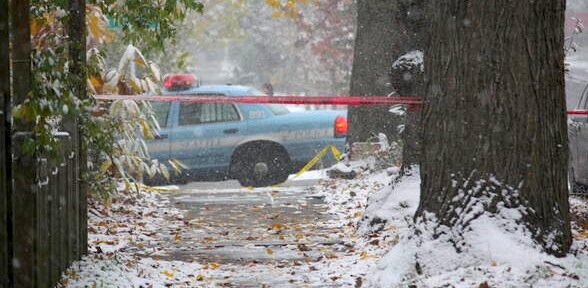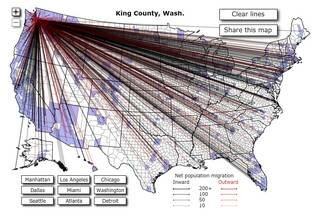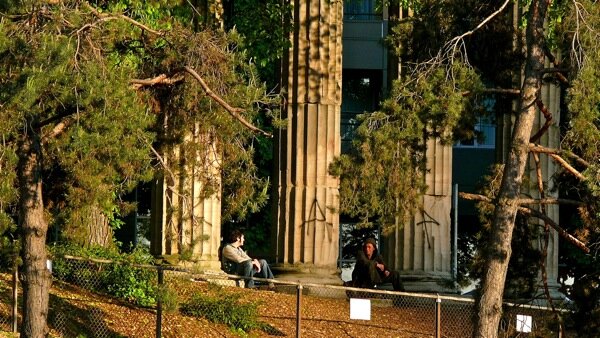 Photo: Capitol Hill Seattle blog
Photo: Capitol Hill Seattle blog
Mid-morning Monday, as snow was falling, Michael LaRosa walked up to a man he didn't know and repeatedly struck the 58-year-old's head with a hatchet, killing him, say Seattle police. The murder, on the 1400 block of East Union Street, occurred in view of students in a nearby school. ("I don't know what came over me, because I've never done murder, you know," LaRosa later told detectives.)
The Seattle Times contacted LaRosa's half-brother, in Florida, who said LaRosa has been diagnosed with paranoid schizophrenia, but occasionally believes he's well enough to quit taking medication. "Since moving to Seattle nearly three years ago, LaRosa had become a patient at Sound Mental Health on Capitol Hill and enrolled in Seattle Mental Health Court as part of a 2009 municipal-court case involving an assault on a security guard," reports the Times.
For Capitol Hill residents, those circumstances bring back all-too-vivid memories of the 2007 New Year's Eve murder of Shannon Harps by a Sound Mental Health patient with paranoid schizophrenia. (CHS: "In 2009, James Williams, who was receiving treatment and medication from Sound Mental Health prior to his crime, pleaded guilty to the stabbing murder of 31-year-old Shannon Harps....")
About a year ago, I wrote a piece called "King County's Mental Health is Deteriorating," based on an interview with Amnon Shoenfeld, director of the King County Mental Health, Chemical Abuse and Dependency Services Division. Schoenfeld mentioned the stress his department was under to deal with people whose mental illnesses made them unsafe for society, as funding was being cut for programs that paid for medications, and kept the dangerously unstable under constant supervision. ...
 Graphic from Washington State Elections
Graphic from Washington State Elections
King County's estimated population is 1.9 million, of which almost 1.1 million are registered voters. Mid-term elections are historically less likely to draw people to the polls, but with all-mail voting, King County doesn't have to draw people anywhere but a mailbox. The result? A new record: 71 percent of King County's voters cast a ballot this year.
That might seem less impressive compared to the 84 percent turnout for the Presidential election in 2008, but it beats 2006's 65 percent, and 2002's 45 percent, handily. The rest of Washington state grumbles about King County "stealing" elections, but the county's impact is thanks to reality's well-known liberal bias: Only 3.6 million of Washington State's 6.6 million residents are registered voters, about 55 percent.
King County, the single most populous county, also has an edge in registered voters, at 58 percent. These marginal differences--in registered voters, in voter turnout--often make the difference. Senator Patty Murray's win this year is a case in point. Statewide, the Murray/Rossi race comes out to roughly 51 to 49 percent, but in King County it's currently breaking 63 to 36 percent, and King Country represents fully one-third of the state's registered voters. (In 2004, King County went for Murray over Nethercutt, 65 to 33 percent.)...
Written by Diana Toledo; reprinted/posted with permission
How a “true” non-partisan candidate can bring real change to King County Council
In 2008 the public demanded greater bi-partisan representation in leadership on the King County Council and voted to make all King County Council positions non-partisan. The community, tired of status quo divisive party politics on both sides, recognized that problems plaguing our communities were not solved by engaging in party ideology or philosophical debates. Simply put, a pothole in our neighborhood is not a Republican pothole or a Democrat pothole; it is a pothole that needs to be fixed.
But when the King County Council became non-partisan at the will of the people, nothing changed. Even now, two years, later we have yet to see any change in the way council members interact with each other; in fact, council members continue to meet (caucus) among the old party ranks, Democrats on one side and Republicans on the other.
The reality is that there is only one true non-partisan in the race. My opponent is a career politician, backed by the political machine and bringing a 10-year history of voting the party line at the state level (resulting in unsustainable spending and huge budget deficits.). We simply cannot afford to vote the status quo any longer; we need new leadership that is willing to transcend party lines in order to do what is best for our communities and our region.
For 15 years I have served King County, building a reputation of integrity and professionalism by working with Democrats, Republicans, and Independents to implement reform, stop animal abuse, and develop a responsible regulatory licensing policy such as the pilot program for accessible taxicab service. As a whistle-blower standing up for King County front-line staff, frustrated customers and your wasted tax dollars, I demonstrated the courage necessary to stand for real reform. ...
I know, the recession is over. But here's the first line of a Seattlepi.com article this morning: "King County Executive Dow Constantine announced Tuesday morning that his proposed budget would eliminate all general fund support for human services." It would also cut ten percent of the sheriff's budget.
That's in response to the county's $60 million deficit. Seattle's projected deficit is now $67 million. The state of Washington, $520 million. Reports Bloomberg: "Washington has reduced spending by $5.1 billion in the past three years, Gregoire said last month. Yesterday, she said the state faces a deficit of almost $4.5 billion in the two-year budget cycle that begins in July." The cuts will come from social services, corrections, and community colleges.
KIRO quotes Arun Raha, the state's chief economist, saying, "In Washington, the job recovery this time around has been slower than in any of the previous four recessions. If you compound that with the fact that the hole we're in is the largest in living memory, you begin to comprehend the magnitude of the problem."
The irony, of course, is that the city, county, and state don't spend that much, proportionally, on social services to begin with. When Constantine zeroes out social services spending--sorry, battered women and anyone who has been raped--he's addressed about one-third of the problem.
But the state is pushing ahead with a plan for a larger replacement of SR 520's floating bridge--work is underway, despite there being $2 billion in funding missing from the $4.65 billion project. (How much larger? "The current SR 520 is 60 ft. wide through Foster Island in the Arboretum. The plan calls for an 133 ft. wide structure," wrote Mayor McGinn in a letter to a group protesting the new bridge's size.)...
People are hustling to pile up money high enough to make $131 million, which is the estimated cost to replace the South Park Bridge, a Scherzer Rolling Lift double-leaf bascule bridge, built about 80 years ago. $80 million has been allocated so far, from the state, King County, City of Seattle, and the Port. $10 million came in just four days after King County applied for it.
You'd be tempted to applaud the sight of so many political assholes and elbows shoveling dollars down South Park way, except for the fact that the bridge will "close" (in its open position) on June 30, and replacement will take at least three years. That should be just enough time to starve out any of the businesses the relied on the 20,000 vehicles the bridge carries daily.
You might wonder how a bridge that carries 20,000 vehicles a day simply arrived at the end of its lifespan with no back-up ready to put in place.
A temporary bridge was ruled out, among other reasons, because the permit process would have "taken years." This is mildly ironic because the 2001 Nisqually Quake damaged the already failing structure significantly; a Seattle P-I story said: "Officials expect to decide soon whether to replace the bridge or rehabilitate it." In 2002, the bridge received a safety rating of 4...out of 100.
Then people drove on it another eight years while officials decided to wait for someone else to pay for it....
 Courtesy of Forbes and the IRS's free datasets, the internet is busy playing with a map of inter-county population migrations from 2008. (The IRS also offers state-to-state migration patterns.)
Courtesy of Forbes and the IRS's free datasets, the internet is busy playing with a map of inter-county population migrations from 2008. (The IRS also offers state-to-state migration patterns.)
With this visual aid, you learn that 83 people moved from the Aleutians West census area to King Co., and that 200 people arrived from Miami-Dade Co., home of Tubbs and Crockett. 268 showed up from Fairfax Co., Virginia, with a per capita income of $62,000. Virginia sends lots of people our way.
In general, though, you can see that Seattle benefits most from West Coast and northern U.S. migratory patterns, with some more determined snowbirds making a beeline for the Florida panhandle. Enjoy.
 Rush hour on a Downtown-bound Metro bus. Traffic heavy, weather bad, everyone a little grumpy.
Rush hour on a Downtown-bound Metro bus. Traffic heavy, weather bad, everyone a little grumpy.
A bulky middle-aged woman in a white t-shirt gets on and drops into the open seat nearest the bus driver. She addresses the back of his head in a loud, quavering voice.
"Is it true they're thinking about getting rid of the ride free zone?"
"There's been talk about it," the driver replies listlessly.
"That's horrible."
A long pause commences while the bus driver considers. "Might keep out some of the riffraff," he offers.
"Well some of us are homeless, and don't have any way to get around except in the ride free zone!"
Now a pause that's far longer and very uncomfortable. The driver breaks the silence.
"Trust me, there's a lo-o-o-ot of riffraff."
The woman harumphs.
"I'm the one who has to deal with them," says the driver.
"Well, you've never been homeless."
"Oh, yes, I have, ma'am," the driver says, his voice suddenly loud and indignant. "Don't tell me what I've been."
"Then you should know what it's like," says the woman, collecting her stuff and moving toward the exit.
"I got myself out of it," says the driver. The woman begins to walk down the stairs.
"Well, good for you," she says, sarcastically, as she climbs off.
KCWTD photo of "Helene," the giant boring machine that could.
When Dow Constantine took over the King County reins, one of the first major decisions he faced was what to do about Brightwater, the wastewater treatment plant that the King County website tells you is scheduled to be finished in 2010. As of last October, construction costs were estimated at between $1.799 billion and $1.84 billion, including 13 miles of tunneling and the plant itself. As a firm number, that estimate can now be torn up.Things are not so rosy underground. To catch you up, VPFK's boring machine named "Rainier" is broken, stuck 330 feet below ground, about halfway through the 4-mile segment it was digging. Worse, it's in a ground-water zone, so any repairs would require somehow pressurizing an area for workers. Worst, there's no guarantee that the machine could be fixed in situ.
On February 18 of this year, Constantine pulled the trigger, and "issued a declaration of emergency enabling the county to waive certain legal requirements and hire the West Tunnel contractor Jay Dee, Coluccio and Taisei (JCT) to complete construction of the remaining two miles of the central BT-3 tunnel."
The (might as well pick up alliteration points) Brightwater boondoggle-in-progress gets a thorough and clinical analysis on Crosscut, courtesy of Doug McDonald (Washington's secretary of transportation from 2001-'07). As a seasoned veteran of these projects, McDonald dives into the nitty-gritty of Brightwater, detailing the project's mechanical and logistical failures thus far, and explaining that much of this simply comes with the territory.
So far as the decision to switch contractors in mid-stream, McDonald points out, Constantine was stuck between a rock and a...broken boring machine. The county had no negotiating leverage with JCT. And that's why the JCT has negotiated language like this:
The Contractor does not guarantee or represent a maximum cost or time to complete all or any section of the Work, and the Contractor does not guarantee or represent it can be completed. [boldface sic]...
(more)
The King Conservation District promotes conservation in rural King County. Of course, in rural King County, "conservation" can be a fighting word. The KCD encourages farmers and landowners to use best practices with incentives and programs, among other things fish and wildlife-y.
This Tuesday, you have the chance to vote for an open position on its five-member board. (It's a three-year term.) The catch is, you've got to vote in person at the library. Per Publicola: "Seattle residents can vote at the downtown public library (1000 Fourth Ave.) between 10:30 a.m. and 7:30 p.m." [Other King county locations here.] It's likely a hassle for most people, but on the other hand, it makes a good reason for a trip to the library if you haven't been in a while.
Your candidates are listed here: Cascade Harvest Coalition Director Mary Embleton, farmer Mara Heiman, realtor Teri Herrera, ecologist and environmental planner Kirk Prindle, and conservationist Max Prinsen. Here and there you get a sense of the underlying tensions, thanks to code words like "property rights" and concerns like water resource management. Choose wisely.
Chris Bushnell (photo via Facebook)
Publicola broke a big story last night, which hinges on Chris Bushnell's imaginary Ph.D. Bushnell, previously a pollster for Mike McGinn during his mayoral campaign "misrepresented his educational background on business cards and during presentations made as a King County employee," asserts Publicola's Erica Barnett. (See this Seattle Weekly story on a Sims/Bushnell dust-up, where Bushnell "holds a PhD in Economics from the University of Washington.")
McGinn's office claims not to be disturbed by Bushnell's misrepresentation because "Bushnell did not claim to have a Ph.D when discussing his appointment with McGinn," and "Bushnell did not provide a resume as part of his hiring process," adds Barnett. Note to McGinn's office: This is not reassuring.
Somewhat feebly, to my ears, Bushnell admitted that the misrepresentative business card's existence was "possible" because at one point he was working toward a Ph.D in economics....
There are some truly awesome--even sublime--figures associated with sewage treatment. Seattle's West Point treatment plant, on a normal rainy day, can handle about 133 million gallons of sewage. It tops out at 440 million gallons. The human mind cannot really process 440 million gallons of anything, let alone...stinky brown water. The West Point site covers 32 acres.
And of course things go wrong. Last December, a faulty sensor let 10 million gallons pump into Puget Sound from West Point in one night. Due to a possible mechanical failure at a Kirkland pump station the day before yesterday, 25,000 gallons flowed into Lake Washington.
But a large part of what King County (and Seattle) is still wrestling with are the overflows that were designed to happen. CSOs are combined sewer overflows, an intermediate step in sewage evolution between the stage when everything (storm drains and residential sewage) poured into the nearest large body of water, and today's Felix-Unger-style set-up, in which sewage is neatly separated from storm water.
King County has 38--and Seattle has 88 (map)--CSOs that allow overflows of a mix of storm water and raw sewage when the system is overwhelmed by rain. The thinking back in the day was that the storm water would dilute the sewage enough, you'd hardly notice. They discharge to Lake Washington, Lake Union, the Lake Washington Ship Canal, the Duwamish River, Elliott Bay, and Puget Sound, to name a few places.
Seattle Pacific University students have learned the rashy way that just because a canal looks cool and inviting, that doesn't mean it's safe to dive in. In fact, because these overflows have been operating for decades, no one knows precisely what might be in the sediment near overflow outlets. As I type this (Wednesday), a CSO is discharging into the canal....
I like to keep the Christmas tree up until I have an epiphany sometime around January 6 ("Hey, this thing is brown and dead and shedding needles everywhere!"). But I realize that in our modern world things happen on a faster schedule. For many people, Christmas is over December 26, and that tree has got to go.
Happily for the environment, in Seattle and all throughout King County you can "tree-cycle," if you haven't flocked it and are not too lazy to remove tinsel and other ornamentation. King County guidelines look less strict than Seattle (they won't accept trees over eight feet). In Seattle, we're more precise about our Christmas tree recycling:
The tree must be less than 4 inches in diameter, and trimmed to 6 feet tall and 4 feet across. Clean trees can also be taken to the Transfer Station for free. If tree is flocked, it must be disposed of as garbage: Cut into pieces in your garbage can, or take to the Transfer Station.
Artificial trees, of course, are not included in the recycling program: "Artificial trees will last for six years in your home, but for centuries in a landfill."
Shot of the Dow Constantine election party around 10:30 p.m., by Seth Kolloen
As SunBreak editor Seth Kolloen continues making his way through the detritus of 101 election night parties in Seattle, I've returned home to the comforts of hot tea and cats to bask in the warm glow of a good night. While the verdict is still out on both the mayoral race and Referendum 71, Seattleites can at least half-relax in the knowledge that they've done well tonight.
The success of the Mike O'Brien-Pete Holmes-Mike McGinn ticket (should McGinn's lead hold) is good news for Seattle, and not just because I agree with their policies. And the groundwork for their success was laid over the last decade, by a dedicated core of activists who nearly (or actually) burned themselves out fighting the prevailing winds on transportation issues, like Cary Moon and Grant Cogswell.
These candidates' success shows that progressives and environmentalists in Seattle can prevail in a one-party climate, which stands in marked contrast to the rest of the country. No doubt John Corzine's defeat in the New Jersey gubernatorial election is already being used as right-wing fodder to suggest the public is turning against President Obama's policies, when in reality it's owed mostly to the corrupt, ossified political culture of New Jersey Democrats.
The Seattlepi.com's description of McGinn's campaign as "populist," while charming, is a disservice. McGinn's success, like Pete Holmes's and Mike O'Brien's, is owed to the fact that he ran on solid policy positions that both appeal to the city's sensibilities while constituting sound, far-sighted choices. While Mike McGinn has backtracked on his opposition to the tunnel, his potential election signals a departure from the failed tenure of Greg Nickels and breathes new life into the city's liberal political culture.
Susan Hutchinson's once-competitive campaign was owed largely to the public's increasing lack of faith in the local Democrats. She was an attempt to hitch the radical, anti-environment policies of the ex-urban fringe to a candidate with suburban appeal. Dow Constantine's decisive victory should put to rest idle talk of the region swinging to the political right. And while it's unlikely to put to rest the town-country divide and the attendant vitriol that was aimed at Ron Sims for his environmentally sound land-use policies, the fact that Sims's protege has prevailed clearly signals that the majority in the region understand that the value of our natural resources justifies the inconveniences.
Pete Holmes's victory is especially pleasing. Tom Carr was fundamentally out-of-step with Seattle in his longstanding battle with the city's thriving night-life. Not only has Seattle unequivocally stated that it believes there's a better way to balance neighborhood quality-of-life with a thriving bar and club scene, but it has spoken strongly in support of the cultural scene--the theaters, rock clubs, galleries, and literary events--that's so closely tied to night-life.
Tomorrow, most commentators will be talking about how King County's overwhelming support for the Approve 71 campaign (roughly two-to-one in favor) played a decisive role in likely swinging the entire state (where it's tentatively passing 51-49 percent), but that's also unfair. Sixty-five percent of King County voters are not pinko commies. The success of the Approve 71 campaign is owed to great outreach to voters of all stripes, and the ability of gay rights advocates to convince the larger community that gays are your friends, neighbors, and co-workers, and at the very least deserve most of the rights and privileges afforded to their straight neighbors.
Oh, and as for Tim Eyman's failure to pass his latest anti-tax initiative? It means nothing except that the vast majority of Washingtonians aren't stupid.
Last week I sat down to talk with King County Metro chief Kevin Desmond about how technology was affecting Metro's interactions with customers and its infrastructure. Besides the popularity of third-party services like One Bus Away, we talked about smart cards, social media, and audience participation.
I brought up the question of continuing the downtown Ride Free Zone during a budget crisis, and Desmond had clearly already been thinking about that topic:
"We're going to experiment with offboard payment at the major stations on the Rapid Ride line. Community transit will also experiment with it on their Swift line. The problem is fare enforcement. You can get on via the back door with your ORCA card, but there's nothing stopping you from pretending to swipe a smart card."
While light rail is typically limited to a few lines and enforcement is a matter of a few inspectors, Desmond pointed out that "in the bus environment, we might have 900 to 1,000 buses we would have to monitor. But we do have federal money...
By coincidence, the same morning I sat down to discuss the success of private bus guides like One Bus Away with King County Metro's general manager Kevin Desmond, One Bus Away released its iPhone application.
The question I had was this--given Metro's well-documented budget woes, was there more than customer convenience to be gained from letting private software developers take on a larger role?
OBA is the brainchild of Brian Ferris, a grad student in Computer Science & Engineering at the UW. Ferris is studying human-computer interactions, so in a sense, Seattle's bus riders are living inside Ferris's experiment.
"What he's done is terrific," said Desmond, who is thin, monologue-prone, and data-driven. In fact, data is the next thing he brings up, pointing out that OBA runs on top of Metro data. "The issue for us with the private developer world is how can we better meet their needs. What standards should we use? We're planning a developer's workshop, probably in late October."
OBA's website and iPhone...






Most Recent Comments